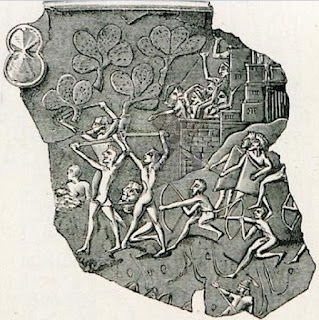It depicts the siege of the coastal city. Defenders have left the walls and are getting ready to engage the enemy.
Women wave their hands on the walls, supporting them with shouts and gestures...
On the very right of the scene we can see two infantry soldiers with shields and spears. In front of them are three archers firing arrows at the enemy...And in front of them all are three slingers in a process of firing sling shots...
Was this the normal position for the slingers? Ahead of the other troops? I presume they would need a good view of the enemy and enough space to swing the sling...
Sling was a deadly weapon...
Publius Flavius Vegetius Renatus wrote that "Soldiers, notwithstanding their defensive armor, fear more the round bullets from the sling than all the arrows of the enemy"...The most common lead bullets among both Greeks and Romans were acorn-shaped.
Some of these molds were made to impart symbols on the sling shot. I am not sure, but I think this is a thunderbolt, a quite an appropriate symbol to put on a sling shot which strikes and kills from a distance like a thunderbolt...
But most of them had inscriptions like these: "This is for dessert", "Here’s a sugar plum for you", "Crack your teeth", "Catch" and several variations of "up [insert the enemy king name here] arse!"...
PS: is this the plant depicted in the background? The so called "prickly pear"?
No, it can not be, even if it is now very common in the Mediterranean. Opuntia is a cactus, like all cactus it is from America undiscovered at the time...But I don't know any other plant, native to Mediterranean, that looks like the plants depicted on this Mycenaean vessel...
Something crazy just occurred to me...Could this vessel be a modern forgery, made well after the introduction of the cactus into the Mediterranean, by someone, who like me, didn't know that this cactus was introduced from America? Ta Ta Taaaaaaaa! 🙂 Mystery...









Very odd, those trees in the background.
ReplyDeleteI for one enjoy speculative, guesswork posts :) Lets you play a little bit, lets us enjoy the dance 👍👍👍
ReplyDeleteWhat is the source of the date for the vessel?
ReplyDeletehttps://www.britishmuseum.org/collection/object/G_1908-1230-16
DeleteStylized oak leaves
ReplyDelete:) I really doubt it...Oak leaves don't look anything like this. Also, why stylising this and nothing else?
Deleteif the prickly pear didn't exist in the Mediterranean circa 1500 BC and that could be seen as evidence of modern forgery... would that not be obvious to the British Museum? Another possibility is the artifact is genuine and could indicate the Americas were not quite so undiscovered at the time. Lake Superior copper didn't walk away. Someone came to mine it. Mexico abounds with intriguing ooparts. Could this be just another in a very long list of things many prefer not to contemplate? So we claim forgery...or stylized whatever.
ReplyDeleteLet's just say archaeologists don't know very much about plants and animals...
DeleteOr how plants and animals transfer from 1 place to another. They do so dislike finding things they shouldn't where the things should not be.
ReplyDelete